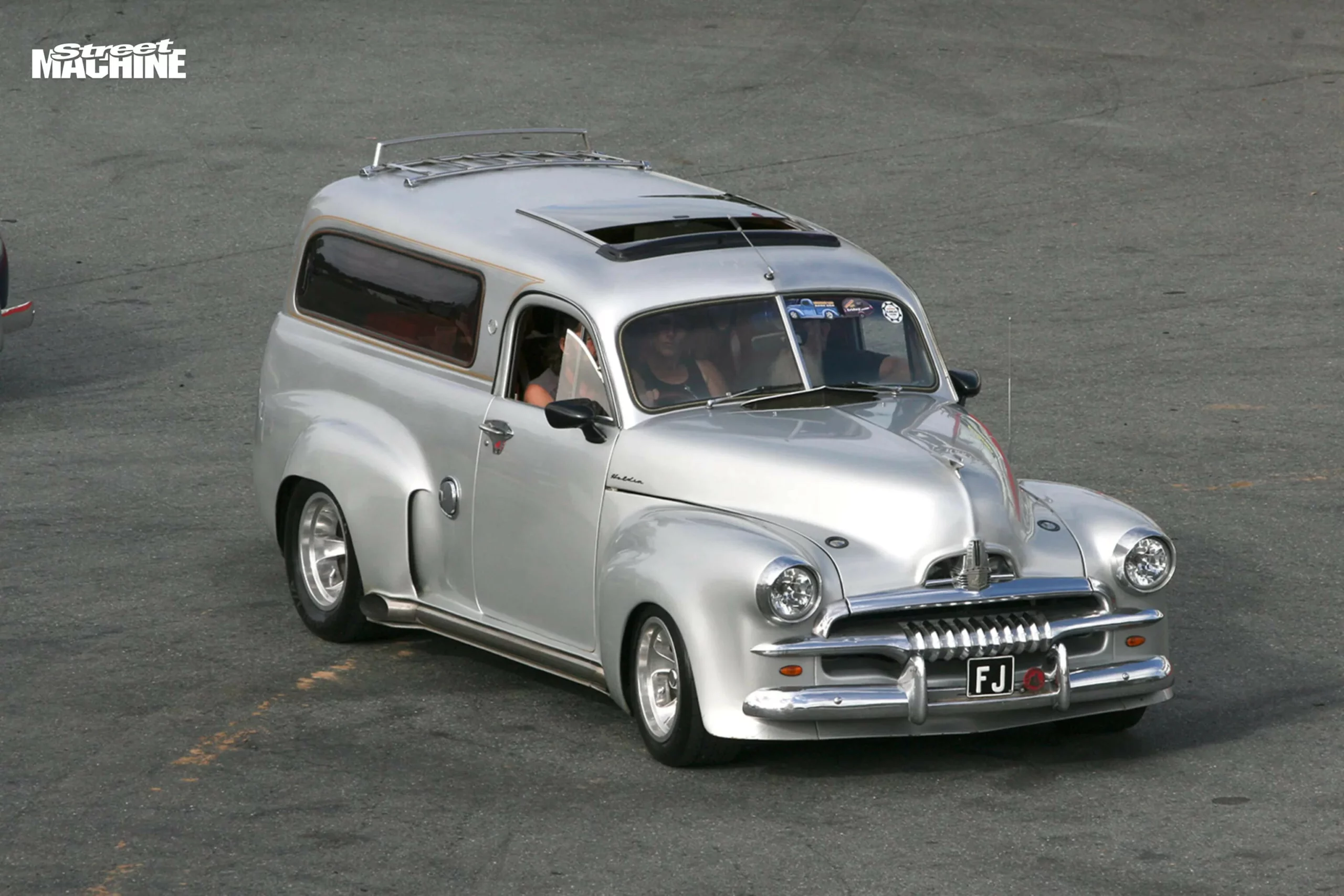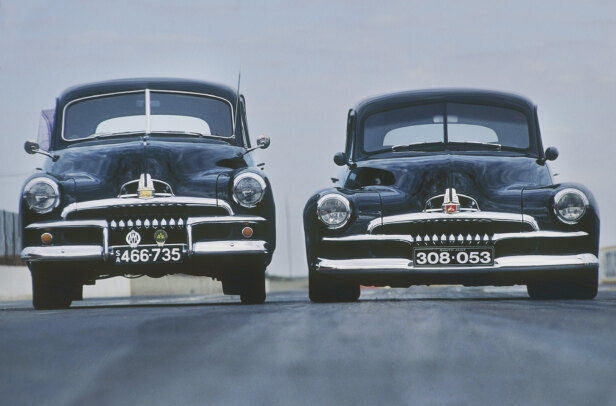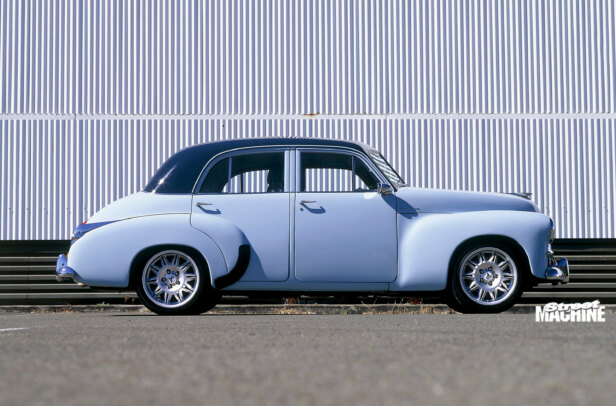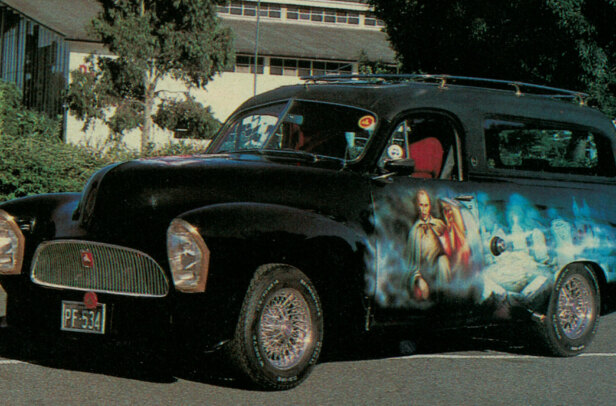If you’ve attended a car show or swap-meet in South East Queensland in the past 45-odd years, you’re sure to have seen Neil Dieckmann’s FJ Holden panel van.
Neil was introduced to the humpy scene by Kyren O’Loan and bought this FJ back in ’74 when the panel van craze was just finding its feet. However, joining those ranks was never really Neil’s intention.
“I had a tidy FJ ute and bought an FJ sedan to do up; I’d dabbled with mods like a one-piece windscreen and bucket seats but was struggling to get a handle on fixing the rust,” he says. “My friend Mark England introduced me to a local panel man called Peter Zorge who took one look at the car and told me to cut it in half and start again. He suggested that I try and find a van as something different to all of the FX-FJ sedans getting around.”
Although FJs were only 20 years old, he looked at plenty of rust-buckets. But sometimes great cars just fall in your lap, which is exactly how Neil scored the pano.
“I was an apprentice at Swanbank Power Station and you could see the new rail link going in across the way. I spied the FJ being used by a local earthmover to haul 44-gallon drums of fuel. He wasn’t keen to sell but the van was in really good original condition.”
So Neil struck a deal: “I said I’d find him a similar condition tilly [that is Queenslander for ute] and scored a tidy EJ for $130; he was happy and I was the proud owner of a cream FJ panel van.”
The FJ was driven in stock form for six months until Neil fitted the obligatory HR front and rear ends, a Torana booster, rack and pinion steering and a 149 red motor backed by an Opel four-speed. This first build was finished by a quick squirt in etch primer and a set of seven and eight-inch US Racers.
“The wheels stuck out past the ’guards and the first flares came about after a cop defected me. By this stage Zorgey and I had become friends and he handled the metalwork.”
The next upgrade included grey primer and sill-hanger side pipes. It was in this guise that it attended the first-ever ASMF Street Machine Nationals, in Griffith in 1975.
The show bug bit hard so the van was stripped. Neil rolled the rear pan, fitted the shortened Fairlane tail-lamp strip and side pipes, and treated the roof to a boot-type luggage rack and a sunroof from a Leyland Mini Sunshine. Fifties Chrysler headlamp rims were virtually a bolt-on fit and the finished shell was sprayed black by Ken Rice.
The interior was trimmed in black and white lambswool and featured a swag of Smiths gauges and a Quadraphonic eight-track.
A grumpy 202 with R/T Charger triple Webers was fitted, backed by a Saginaw gearbox. The HR diff housing cracked from the stress of the 10in tyres, so a Fairlane nine-inch packed with a Detroit Locker and 3.9 gears was slotted in.
In 1977, Neil and some friends from Super Vans Inc headed to Sydney’s first van show, at the Norman G Booth Holden dealership. The van craze was in full swing and Neil was winning plenty of awards.
For ’78 Neil got stuck into another makeover, in silver. Peter Zorge painted the van after fabricating a steel front spoiler and reworked the flares.
“The new steel flares were made up from extra pairs of FJ sedan rear guards to keep the profiles in proportion with the rest of the body, with the vents added to fool the police on how wide they actually were. I kept on going bigger with the rear wheels so the flares just kept growing! [Laughs]. People used to say it looked like a pregnant roller skate and it earned me the nickname Harry Hot Wheels.”
US Racers 14×10 rims were jammed under the rear, while Neil and Peter fabricated the neat recesses to house the new side pipes.
It scooped plenty of tinware at the Exhibition Ground shows and the Indooroopilly, Ipswich and Sundale shopping centre car shows, and continued its winning ways within the FX-FJ ranks.
“We did some crazy displays; we made a pool using tarps and railway sleepers, then sat the van on blocks in the middle of it. We’d fill the pool so the van looked like it was floating, add a fountain, frogs and lillies and even dye the water blue with heaps of Blue Loo! The judges used to hate it because they couldn’t get close to it without gumboots, and you could guarantee that I’d be the last to leave every show as we had to wait for everyone else to clear out so I could let the water go.”
Minor updates included twin XB GT fuel fillers and a reworked console incorporating VB Commodore switchgear and vents.
By 1980 Neil had bought some land and set about building his own house, so work on the van tapered off. In the mid-80s, Bill Jones of Weldwell Engineering made a pair of 13×7 12-slotters for the front, while the 14x10s on the rear came from Malcolm Body’s black HT van, ‘Midnight Oil’. Under the bonnet the current 192 was added, detailed in maroon. A Sigma rear seat made the van more family-friendly, and the Dieckmanns covered plenty of miles up and down the East Coast.
The big US Racers made a return in the early 90s and it stayed that way until a few years ago, when the local transport authorities caught up. With no documented approvals on hand due to the age of the build, the FJ had to be re-engineered to more modern specs.
With advice from John Kean, Neil upgraded the front brakes to Ford-pattern HQ items and decided the nine-inch was overkill, replacing it with a Hilux diff. The new stud pattern was sorted by a set of 15in US Kustom mags, measuring 8in and 10in for show duties. Due to the twin exits and lack of heat-shielding, the side pipes had to be capped.
The pipes remain on for show and with a time capsule like this that features many period accessories and styling cues, it’d be devastating to see it too drastically altered. The 30-plus-year-old paint has needed a couple of touch-ups and the interior is starting to fade but it still draws admiring glances from all ages. Just goes to show that neat mods and a sensible approach to an overall look are a timeless combination.
Neil’s other automotive love is a 1926 Dodge Four buckboard ute. The Dodge started life as a tourer but like many vehicles of this era was cut down and served its time at a tin mine in Emerville, NSW.
Neil purchased the Dodge eight years ago and he and the tilly have become popular sights on Brisbane streets. They’re regularly invited to attend community parades and car events. With rear brakes only — as from the factory — and an 80km/h top speed, it makes for some interesting trips.
Neil has fitted the ute out with plenty of period accessories that are either bolted, tied, wired or just plain hanging on for dear life, and its no surprise that he has earned himself the nickname of ‘Jed’.
“The FJ and the Dodge are a load of fun to take out,” he says. “They just fit in everywhere.”




Comments